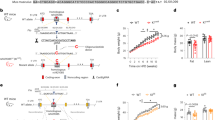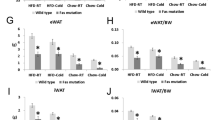Abstract
Uncoupling protein 1 (UCP1) is uniquely expressed in brown adipose tissue (BAT) and generates heat by uncoupling respiration from ATP synthesis. A defect in BAT thermogenesis has been described in different models of rodent obesity. In humans, the implication of BAT in energy expenditure is still under discussion. A BclI polymorphism associated with fat gain over time has been described in the upstream region of the human UCP1 (hUCP1) gene. In this study, a new polymorphic site linked to the BclI site is described which results in a C to A point mutation, 89 bp downstream of the BclI site, ie at position −3737 bp. This site is located in the recently analysed regulatory region of the hUCP1 gene. The mutation disrupts a consensus site for the binding of ATF/CREB transcription factor family and inhibits the factor binding in vitro. However, transient transfection of a rodent brown adipocyte cell line shows that the isoproterenol (ISO) stimulation of the hUCP1 gene transcription is not significantly affected by this mutation. However, we postulate that the C/A substitution, in human, may contribute to a minor defect in the regulation of hUCP1 transcription and that would explain fat gain over time.
This is a preview of subscription content, access via your institution
Access options
Subscribe to this journal
Receive 12 print issues and online access
$259.00 per year
only $21.58 per issue
Buy this article
- Purchase on Springer Link
- Instant access to full article PDF
Prices may be subject to local taxes which are calculated during checkout

Similar content being viewed by others
References
Nicholls DG, Locke RM . Thermogenic mechanisms in brown fat Physiol Rev 1984 64: 1–64.
Lowell BB, Susulic V, Hamann A, Lawitts JA, Himms-hagen J, Boyer BB, Kozak LP, Flier JS . Development of obesity in transgenic mice after genetic ablation of brown adipose tissue Nature 1993 366: 740–742.
Enerback S, Jacobsson A, Simpson EM, Guerra C, Yamashita H, Harper ME, Kozak LP . Mice lacking mitochondrial uncoupling protein are cold-sensitive but not obese Nature 1997 387: 90–94.
Cassard AM, Bouillaud F, Mattei MG, Hentz E, Raimbault S, Thomas M, Ricquier D . Human uncoupling protein gene: structure, comparison with rat gene, and assignment to the long arm of chromosome 4 J Cell Biochem 1990 43: 255–264.
Cassard-Doulcier AM, Bouillaud F, Chagnon M, Gelly C, Dionne FT, Oppert JM, Bouchard C, Chagnon Y, Ricquier D . The Bcl I polymorphism of the human uncoupling protein (ucp) gene is due to a point mutation in the 5′-flanking region Int J Obes Relat Metab Disord 1996 20: 278–279.
Oppert JM, Vohl MC, Chagnon M, Dionne FT, Cassard-Doulcier AM, Ricquier D, Perusse L, Bouchard C . DNA polymorphism in the uncoupling protein (UCP) gene and human body fat Int J Obes Relat Metab Disord 1994 18: 526–531.
Clement K, Ruiz J, Cassard-Doulcier AM, Bouillaud F, Ricquier D, Basdevant A, Guy-Grand B, Froguel P . Additive effect of A→G (−3826) variant of the uncoupling protein gene and the Trp64Arg mutation of the beta 3-adrenergic receptor gene on weight gain in morbid obesity Int J Obes Relat Metab Disord 1996 20: 1062–1066.
Fumeron F, Durack-Bown I, Betoulle D, Cassard-Doulcier AM, Tuzet S, Bouillaud F, Melchior JC, Ricquier D, Apfelbaum M . Polymorphisms of uncoupling protein (UCP) and beta 3 adrenoreceptor genes in obese people submitted to a low calorie diet Int J Obes Relat Metab Disord 1996 20: 1051–1054.
Oberkofler H, Dallinger G, Liu YM, Hell E, Krempler F, Patsch W . Uncoupling protein gene: quantification of expression levels in adipose tissues of obese and non-obese humans J Lipid Res 1997 38: 2125–2133.
Esterbauer H, Oberkofler H, Liu YM, Breban D, Hell E, Krempler F, Patsch W . Uncoupling protein-1 mRNA expression in obese human subjects: the role of sequence variations at the uncoupling protein-1 gene locus J Lipid Res 1998 39: 834–844.
Gonzalez-Barroso M, Pecqueur C, Gelly C, Sanchis D, Alves-Guerra MC, Bouillaud F, Ricquier D, Cassard-Doulcier AM . Transcriptional activation of the human ucp1 gene in a rodent cell line. Synergism of retinoids, isoproterenol, and thiazolidinedione is mediated by a multipartiteresponse element J Biol Chem 2000 275: 31722–31732.
Fink JS, Verhave M, Kasper S, Tsukada T, Mandel G, Goodman RH . The CGTCA sequence motif is essential for biological activity of the vasoactive intestinal peptide gene cAMP-regulated enhancer Proc Natl Acad Sci USA 1988 85: 6662–6666.
Sassone-Corsi P . Cyclic AMP induction of early adenovirus promoters involves sequences required for E1A trans-activation Proc Natl Acad Sci USA 1988 85: 7192–7196.
Nichols M, Weih F, Schmid W, Devack C, Kowentz-Leutz E, Luckow B, Boshart M, Schutz G . Phosphorylation of CREB affects its binding to high and low affinity sites; implications for cAMP induced gene transcription EMBO J 1992 11: 3337–3346.
Maekawa T, Sakura H, Kanei-Ishii C, Sudo T, Yoshimura T, Fujisawa J, Yoshida M, Ishii S . Leucine zipper structure of the protein CRE-BP1 binding to the cyclic AMP response element in brain EMBO J 1989 8: 2023–2028.
Deutsch PJ, Hoeffler JP, Jameson JL, Lin JC, Habener JF . Structural determinants for transcriptional activation by cAMP-responsive DNA elements J Biol Chem 1988 263: 18466–18472.
Lamas M, Sassone-Corsi P . Coupling transcription to signal transduction: CREM and cAMP. In: Papavassiliou AG (ed). Transcription factors in eukaryotes Landes Bioscience 1997 50–65.
Zhao J, Cannon B, Nedergaard J . alpha 1-Adrenergic stimulation potentiates the thermogenic action of beta3-adrenoreceptor-generated cAMP in brown fat cells J Biol Chem 1997 272: 32847–32856.
Acknowledgements
We thank Dr K Clément for the gift of human DNA especially for the control population. We thank Dr F Fumeron for helpful discussion.
This work was supported in part by the Centre National de la Recherche Scientifique (CNRS), the Institut National de la Santé et de la Recherche Médicale (INSERM), the Association pour la Recherche contre le Cancer (ARC), the Human Frontier Science Program organization (HFSP), and the Institut de Recherches Servier.
M del Mar Gonzalez-Barroso was supported by a grant from the European Union (Marie Curie Mobility Training fellowship) and an associate researcher fellowship of the CNRS.
Author information
Authors and Affiliations
Corresponding author
Rights and permissions
About this article
Cite this article
Rousset, S., del Mar Gonzalez-Barroso, M., Gelly, C. et al. A new polymorphic site located in the human UCP1 gene controls the in vitro binding of CREB-like factor. Int J Obes 26, 735–738 (2002). https://doi.org/10.1038/sj.ijo.0801973
Received:
Revised:
Accepted:
Published:
Issue Date:
DOI: https://doi.org/10.1038/sj.ijo.0801973
Keywords
This article is cited by
-
Genetic and environmental pathways to complex diseases
BMC Systems Biology (2009)



